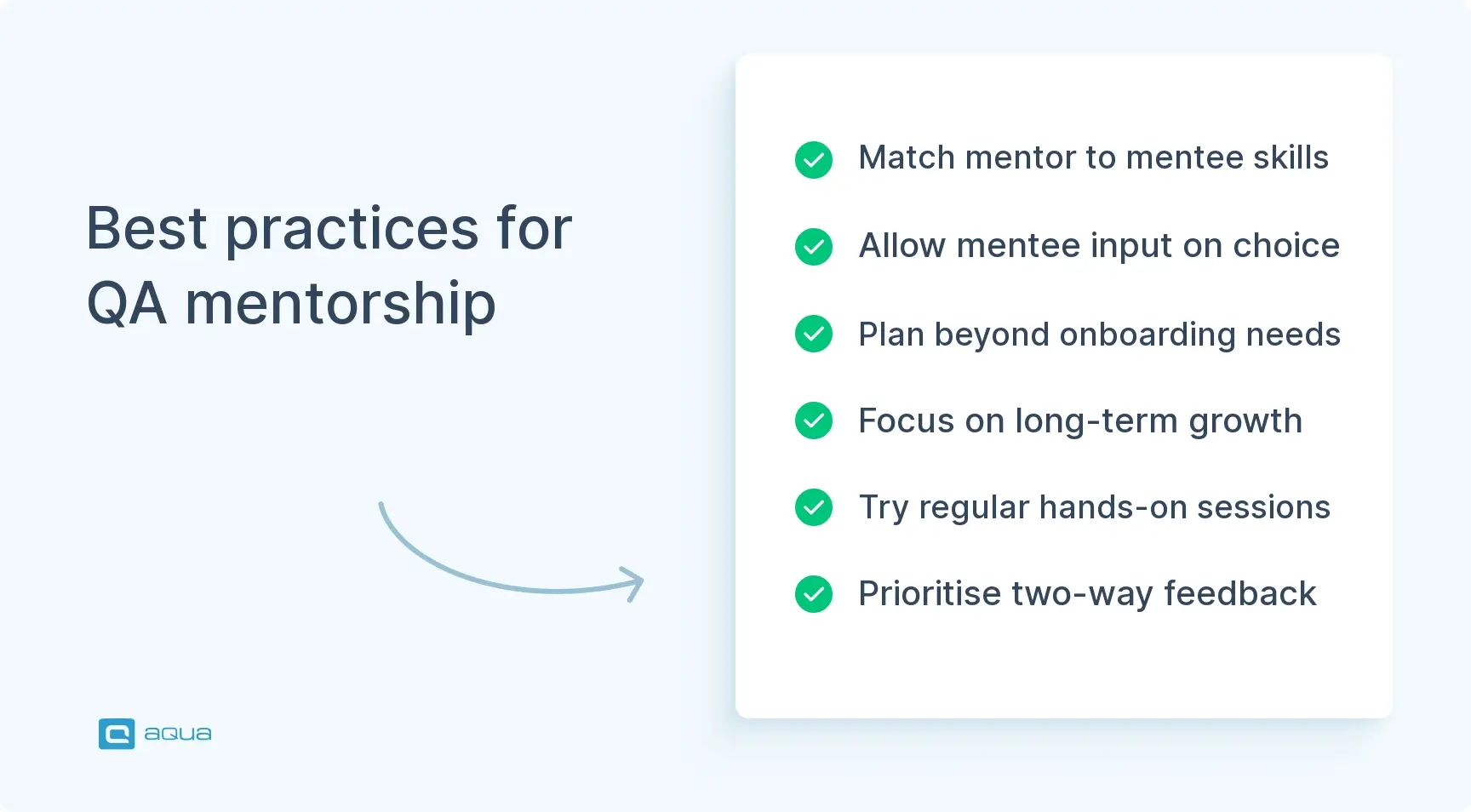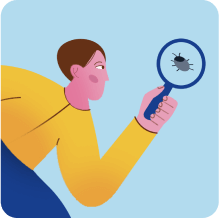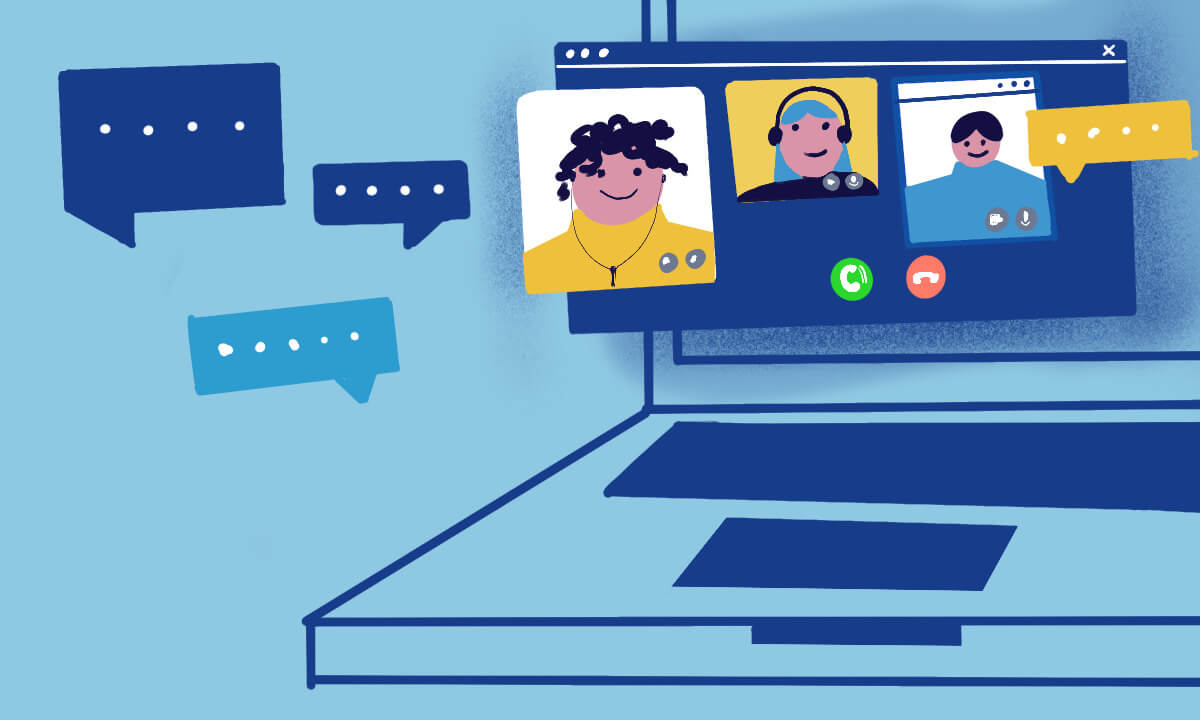Best practices of implementing mentorship in QA team
Match the right people
As an employee, there is a bit of common wisdom to how you pick a mentor. Such a person should not be too junior, because they will not be able to help you much with hard skills. A mentor should not be too senior either, because they would not be able to relate to the challenges of a fresh specialist.
Select QA mentors with both company experience and expertise matching mentee goals in areas like automation or test strategy. Let mentees have input in the selection process and run quick compatibility checks before finalising pairs. Recently promoted seniors often make excellent mentors but just remember to equip them with coaching skills. This approach reduces onboarding time while improving knowledge retention significantly.
Focus on long-term
Do not confuse mentorship with onboarding covering management of testing processes. One’s QA mentor should not just provide advice on immediate problems and dwell on the procedures of the company. The goal here is to elevate a recent hire as a specialist, and that takes some planning.
Look beyond the daily grind of your project and build a shared growth roadmap with your QA mentee. Map out both quick wins and future aspirations that transcend their current responsibilities. This might include pairing them with developers, plugging them into technical forums, or tackling a challenging test automation task together. Check in on progress regularly – acknowledging small victories keeps motivation when deadlines approach.
Get hands-on
Just as devs thrive with pair programming, your QA mentees need similarly hands-on approaches. Try running joint debugging sessions where you troubleshoot together, or review their automated scripts with targeted feedback. Not just critiques but genuine coaching moments. One often-overlooked technique is assigning a contained “failure-safe” testing scenario that lets them experiment without risking production systems. Many mentors make the mistake of keeping real tools off-limits too long; instead, you should let them poke around with proper guidance. When teams implement structured pair testing even once weekly, knowledge transfer typically happens twice as fast as with traditional documentation methods.
Sometimes, a learning session is a good middle ground. While I always advocate for letting people roll with the testing punches, it’s a good idea to help your colleagues be prepared. Group and one-on-one sessions are not also good learning opportunities but a place to ask questions and, let’s be honest, share some early grievances for a productive outcome (or stress relief).
Speaking of practical sessions, it could be useful to show people around the tools that your team uses. There is usually more nuance and tricks that make it to general documentation. We do that ourselves when hiring new people to work on our QA testing tool aqua.
Adapting Mentorship for Remote and Distributed QA Teams
Remote QA teams need a different approach to mentorship – but don’t worry, distance won’t dilute quality. Start with detailed profiles for smart mentor-mentee matching, then kick things off with a virtual meet-and-greet to test chemistry. Lock in regular video sessions and get comfortable with collaborative tools like shared screens and digital whiteboards for those critical hands-on moments.
Clear communication expectations are non-negotiable here. Both parties should agree upfront on how and when to connect. Many teams see better results by scheduling shorter, more frequent check-ins rather than lengthy monthly calls that risk losing momentum.
Don’t forget about informal mentoring either. Virtual coffee chats, themed Slack channels or online QA meetups create those water-cooler moments where some of the best learning happens. Teams that nail this remote approach often see engagement jump by nearly 40% – proving that quality mentorship has nothing to do with sharing physical space.

Intuitive solution so you can mentor about testing, not clicking buttons
Mistakes to avoid when implementing mentorship in a testing team
Assigning a mentor short-sightedly
So, you’ve found the right person for a new employee. They are a recently promoted senior tester. They communicate well. They are a leader in the making. There is just one problem: they are taking a three-week vacation really soon. Do you pick someone else instead? No: a few weeks without a mentor is better than years of career affected by a less suitable mentor.
On a similar note, don’t look at mere formalities when picking a mentor. Give it at least a few days to see who the new employee is getting a good personal connection with. Consider the potential mentor’s career development plan. Are they looking to eventually transition into a management job? Do they plan to stick around at your company for long? Answers to these questions are just as important as the mentor’s skills.
Lacking a plan
Much like any process that requires improvisation, mentorship can degrade if you are missing a plan that you improve from. Mentorship is most effective when you define goals and plan outcomes. Using such a framework also makes mentorship rewarding for the employee, as they see their progress every month or even faster than that.
Not securing upper management’s commitment
Make no mistake (you’re in QA after all): mentorship will pull time away from other tasks. Your team will be getting slightly behind if you maintain the same workload. Pitch your QA mentorship program to leadership upfront with solid business outcomes – faster onboarding, better retention, and fewer bugs. Don’t just talk benefits – show them with a couple of basic metrics that matter. Staggeringly, mentored testers typically find critical defects 30% faster. Connect your proposal to company goals, and you’ll secure both genuine support and that precious dedicated time mentors need to make a real difference.
Benefits of mentorship in QA
Just to reaffirm that this is worth the hassle, here are the advantages of mentorship in QA:
- Smooth integration of new employees into the team
- Sense of belonging
- Increased professional growth
- Improved output that requires less input from senior testers
- New perspective on seemingly mundane things for the mentor
- Additional company loyalty
Measuring Success and Sustaining Your QA Mentorship Program
Keep your mentorship program sharp with regular check-ins and tweaks. Don’t rely on gut feelings, track real progress with concrete metrics. Is onboarding faster? Has bug detection improved? Are your automation numbers trending up? Quick monthly surveys can reveal what’s working and what’s not. Have mentees create 30-60-90 day learning roadmaps – it keeps everyone focused and makes progress visible.
Share wins with leadership in quarterly snapshots – nothing fancy, just the highlights. As you grow, try mixing things up with small group sessions (3-4 people max) to stretch your mentoring resources. A designated program coordinator – even part-time – can save you headaches when scaling beyond 10+ participants. Measure what matters, adjust as needed, and watch your QA team level up together.
Conclusion
QA mentorship is extremely beneficial for both the new employee and the company. Yes, it takes some preparation on your side and some accommodation from stakeholders to give you the required time. The benefits, however, amplify beyond a single person assigned to one project.
Collaborative testing solution to make mentorship practical


















